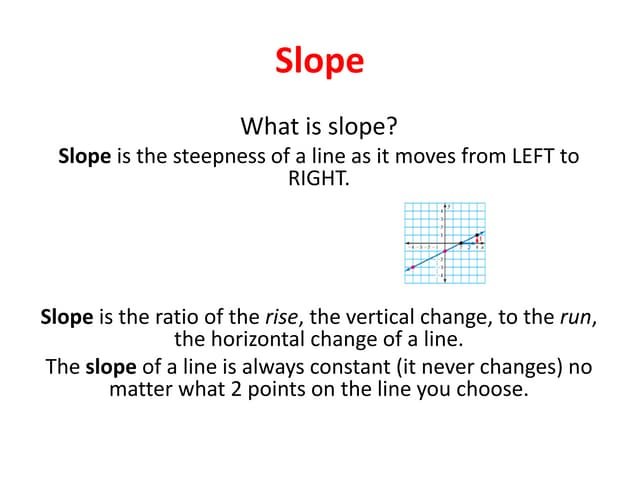In the realm of mathematics, particularly within the study of algebra and geometry, the concept of slope is fundamental. Understanding how to find the slope of a line is not just a skill confined to the classroom; it extends its utility into various real-world applications, including engineering, physics, and even everyday decision-making. This article delves deep into the methods of finding slope, ensuring a thorough grasp of its principles and applications.
The Essence of Slope
At its core, the slope of a line represents the rate at which it rises or falls as it moves from left to right across the Cartesian plane. This is why slope is often referred to as the “rise over run.” In more technical terms, it quantifies the change in the vertical (y) position relative to the change in the horizontal (x) position between two distinct points on a line. This concept is not just limited to straight lines but extends to any curve, where the slope at any given point can be considered as the slope of the tangent at that point.
Key Methods to Determine Slope
The Formula Approach
The most straightforward method to find the slope is by using the slope formula:
�=�2−�1�2−�1 m=x2−x1 y2−y1, where �m represents the slope, and (�1,�1)(x1,y1) and(�2,�2)(x2,y2) are the coordinates of any two points on the line. This formula gives a clear numerical value to the slope, making it easy to interpret the line’s steepness and direction. A positive slope indicates an upward trend from left to right, while a negative slope indicates a downward trend.
Graphical Interpretation
For those who prefer a more visual approach, the slope can also be determined graphically. By plotting the line on a graph and selecting two points, one can simply count the number of units moved vertically (the rise) and horizontally (the run) from one point to the other. Dividing these two values will yield the slope. This method not only aids in understanding the concept of slope but also helps in visualizing the steepness and direction of the line.
Using Equations
Lines are often represented by equations, most commonly in the slope-intercept form:
�=��+�y=mx+b, where� m is the slope and � b is the y-intercept. When a line’s equation is known, identifying the slope becomes a matter of extracting the coefficient of � x, which directly represents the line’s slope. This method is particularly useful in algebraic manipulations and when dealing with multiple lines, as it allows for easy comparisons of slopes.
The Calculus Connection
In calculus, the concept of slope takes on a new dimension when dealing with curves. Here, the slope of a curve at any given point is found using derivatives. The derivative of a function at any point gives the slope of the tangent line to the curve at that point, providing a dynamic view of slope as it changes along the curve. This approach is essential in understanding the behavior of complex functions and their rates of change.
Real-World Applications of Slope
Beyond the confines of academic study, the concept of slope finds numerous applications. In engineering, slope calculations are crucial in designing roads, bridges, and ramps, ensuring safety and functionality. In the field of economics, slope is used to represent rates of change, such as in supply and demand curves, offering valuable insights into market dynamics. Even in everyday scenarios, understanding slope can aid in tasks as simple as determining the angle of a roof or the incline of a hill.
Conclusion
The journey to understanding how to find the slope is filled with various methods and applications, each offering unique insights into this fundamental concept. Whether through formulas, graphical interpretation, equation analysis, or calculus, the ability to determine and understand slope is a powerful tool in both mathematical studies and real-world applications. As we continue to explore and apply this concept, its relevance and utility only grow, highlighting the importance of mastering the art of finding slope in our quest for knowledge and practical solutions.
FAQs on How to Find Slope
1. What is the slope of a line?
The slope of a line measures its steepness and direction. It’s defined as the ratio of the vertical change (rise) to the horizontal change (run) between two points on the line.
2. What does a positive or negative slope indicate?
A positive slope indicates that the line rises as it moves from left to right, while a negative slope means the line falls. A slope of zero indicates a horizontal line, and an undefined slope corresponds to a vertical line.
3. Can the slope be a fraction or decimal?
Yes, the slope can be expressed as a fraction, decimal, or whole number. It represents the rate of change and can take any real value.
4. How do you find the slope from a graph?
On a graph, you can find the slope by picking two points on the line, calculating the rise (vertical change) and run (horizontal change) between them, and then dividing the rise by the run.
